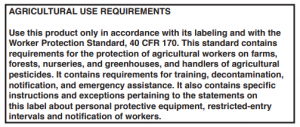In September 2015, the U.S. EPA announced Revisions to the Worker Protection Standard. Content in this website reflects these revisions. Click here to visit the EPA’s WPS website.
The Worker Protection Standard (WPS) is a regulation from the U.S. Environmental Protection Agency (EPA) designed to limit workers’ exposure to pesticides. The WPS requires owners or managers of an agricultural establishment (any farm, forest, nursery or greenhouse) to provide employees with specific information, equipment and services. This regulation is enforced by the pesticide regulatory agency (or, State Lead Agency) in your state. People who violate the WPS may be fined and/or have their pesticide applicator certification suspended or revoked.
WPS covers any pesticide that has an “Agricultural Use Requirement” section on the label (see example). The label information does not provide all that is needed to comply with the WPS. The WPS does not apply when pesticides are used on pastures; to control rodents; as bait in traps; on harvested plants; for public pest control; on livestock; on home fruit, vegetable gardens or lawns; and on non-crop areas such as along roadways.
The WPS outlines good safety practices for all farmers who use pesticides in their operations. Even if compliance is not required, consider using the WPS as a guide to develop your own safe practices and habits.
- Think about the pesticides you use, when each is used, who applies them or who might come into contact with them, either directly or indirectly.
- Always read the pesticide label and follow precautionary statements carefully. Remember, the label is the law.
Topics Covered in this Module
Technical inputs provided by Wayne Buhler, PhD

